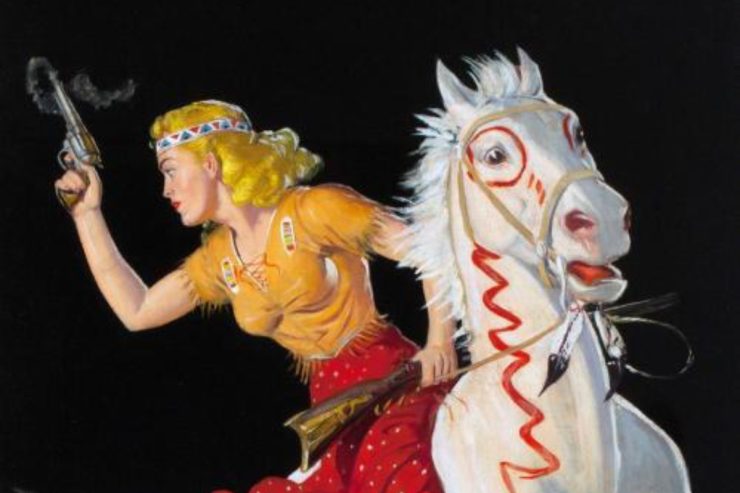Pulp magazines have influenced writers, artists, film directors, software developers, and countless others over the years. Our “Pulp History” articles focus on the rough-paper writers, editors, publishers, and artists who have inspired and continue to inspire the creators of the world’s popular culture.
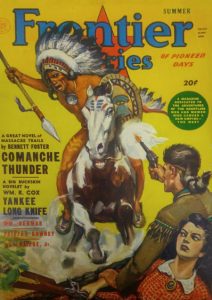 Although Fiction House published a wide variety of pulp magazines — adventure, aviation, detective, jungle, love, science fiction, and sports — western fiction was the primary focus of many of its pulps
Although Fiction House published a wide variety of pulp magazines — adventure, aviation, detective, jungle, love, science fiction, and sports — western fiction was the primary focus of many of its pulps
During the 1920s, the publisher boasted that it published “Real Cowboy Stories and Pictures by Real Cowboys.” Leading writer Walt Coburn — whom Fiction House billed as “The Cowboy Author” — grew up on a working ranch in Montana. Writer and artist Will James learned to be a cowboy in the Canadian province of Saskatchewan during the early years of the twentieth century. He later went to prison for cattle rustling.
Action Stories, Civil War Stories, Frontier Stories, Indian Stories, Lariat Story Magazine, North-West Stories, Novelettes, Tops in Western Stories, Two Western Action Books, Two Western Books, and Walt Coburn’s Action Novels published countless western yarns.
Although Coburn’s work continued to appear in Fiction House’s western pulps through the summer of 1943, “The Cowboy Author” was eventually overshadowed by a low-down city slicker.
Les Savage, Jr. was twenty years old when his western fiction began appearing in the pulps. “Blood Star Over Santa Fe” — his first published story — ran in the Summer 1943 Fiction House pulp, Frontier Stories. Four more quickly followed in Popular Publications’ Fifteen Western Tales, Dime Western Magazine, Star Western, and 10 Story Western Magazine before “Bullets and Bullwhips” appeared in the October 2, 1943 number of Street & Smith’s Western Story. Savage’s story was accompanied by an autobiographical sketch written by the young author.
Though California is certainly a Western state, I’m afraid I can’t justly qualify as a Westerner. I’ve spent most of my twenty years in Hollywood. But if my background is disappointing, at least my family belongs to the Old West. My great uncle was a Texas Ranger, shot in the back by a moonshiner. I still have the vest he wore, the one given to him by an Indian friend, its front beautifully worked in beads, its back cut to shreds by the double load of buckshot the moonshiner sent his way.
My grandfather can remember driving a herd of cattle down Los Angeles’ Main Street, which would be comparable to chasing a bunch of steers across 42nd and Broadway, New York City. My grandmother saw Denver in its wildest day, and I still spend many an hour listening to her hair-raising tales.
I hope the fans won’t rebel against a city slicker writing their yarns, because to me that period of the country’s growth in which the Old West flourished is one of the most fascinating times in the world’s history, and I don’t think it will ever lose its appeal.
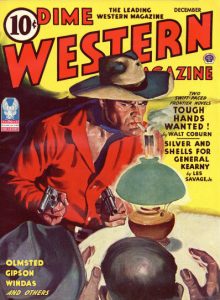 Les Savage, Jr. was born in Alhambra, California on October 10, 1922. The son of a silent film actress and a Hollywood still photographer, the author grew up in Los Angeles. Hoping for a career in art, Savage enrolled in Los Angeles City College. He turned to writing during his second year of college and never looked back.
Les Savage, Jr. was born in Alhambra, California on October 10, 1922. The son of a silent film actress and a Hollywood still photographer, the author grew up in Los Angeles. Hoping for a career in art, Savage enrolled in Los Angeles City College. He turned to writing during his second year of college and never looked back.
From 1943 to 1950, Savage wrote nearly ninety stories — most novella length — for the western pulps. His major market was Fiction House — Action Stories, Frontier Stories, Indian Stories, Lariat Story Magazine, and North-West Romances. He also appeared fairly regularly in Popular Publications’ western pulps, as well as in Argosy. In 1951, his main magazine market became Dell Publishing’s Zane Grey’s Western Magazine, edited by Don Ward. His last sale to the Dell magazine was “Danger Rides the River,” published in the March 1953 number. His writing was marked by realism, atmosphere, and attention to detail, coupled with fast-moving and violent action.
Despite his years, Savage was greatly respected by his peers. In his foreword to In the Land of Little Sticks (2000), Fiction House regular Dan Cushman reported:
We might appear on the same full-color jacket, in an almost fluorescent ink, and it was that Les Savage, Jr. that drew the eye. . . . For whatever reason, it was a name to be noticed and to be at ease with. It was a great name. I know, having shared a number of covers with him, that my Dan Cushman was always upstaged.
Best remembered today for the half-dozen Señorita Scorpion stories that he penned for Action Stories — probably written to order as Fiction House sexualized its covers during World War II — Les Savage, Jr. turned to novel writing during the late 1940s. His first book, Treasure of the Brasada, was published by Simon and Schuster in 1947. Over the next twelve years, another two dozen followed, including the posthumously published Gun Shy (completed by Dudley Dean) and Doniphan’s Ride, a historical novel. Although most of his novels appeared under his own byline, seven were published using pseudonyms.
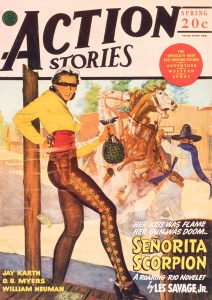 During the 1950s, Savage also began writing for television and film. In 1953, he penned “No Compromise” for Schlitz Playhouse of Stars, a half-hour anthology series that ran on CBS from 1951 – 1958. He wrote two more teleplays for the series in 1954. A few years later, he adapted one of his pseudonymously published paperback originals for the silver screen. The White Squaw was released by Columbia Pictures in 1956. In 1958, he wrote a second screenplay for Columbia, adapting his 1955 Dell paperback original Return to Warbow to film. Other screenwriters also adapted his work to film, including The Doctor at Coffin Gap (starring Gene Autry and filmed as Hills of Utah), The Wild Horse (filmed as Black Horse Canyon and starring Joel McCrea), and “Dangerous Orders,” an excellent short story originally published in the April 1951 issue of Zane Grey’s Western Magazine. Adapted by John McGreevey and D. D. Beauchamp, it ran on Dick Powell’s Zane Grey Theatre in 1957.
During the 1950s, Savage also began writing for television and film. In 1953, he penned “No Compromise” for Schlitz Playhouse of Stars, a half-hour anthology series that ran on CBS from 1951 – 1958. He wrote two more teleplays for the series in 1954. A few years later, he adapted one of his pseudonymously published paperback originals for the silver screen. The White Squaw was released by Columbia Pictures in 1956. In 1958, he wrote a second screenplay for Columbia, adapting his 1955 Dell paperback original Return to Warbow to film. Other screenwriters also adapted his work to film, including The Doctor at Coffin Gap (starring Gene Autry and filmed as Hills of Utah), The Wild Horse (filmed as Black Horse Canyon and starring Joel McCrea), and “Dangerous Orders,” an excellent short story originally published in the April 1951 issue of Zane Grey’s Western Magazine. Adapted by John McGreevey and D. D. Beauchamp, it ran on Dick Powell’s Zane Grey Theatre in 1957.
In his introduction to the 1996 Dorchester edition of Fire Dance at Spider Rock, the late western writer T. V. Olsen suggested:
Savage’s plots are extremely elaborate, well-constructed, and carefully knit. His descriptions are very detailed and striking. Reading a Savage novel, you could see in your mind’s eyes events unfolding as if you were watching a motion picture. . . . The Italian director Sergio Leone has been credited with injecting dust-and-grit reality and a blood-and-guts depiction of violence back into recent Western movies . . . Yet they seem pallid in comparison to Les Savage’s treatment of the same in the early 1950s. Some of it is sanguinary enough to curdle the digestion even of a reader of the 1990s.
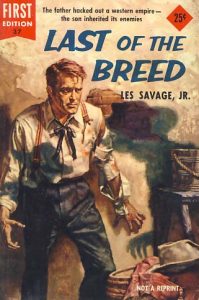 Born one hundred years ago today, Les Savage, Jr. passed away on May 26, 1958. Only 35 years old and suffering from diabetes and high cholesterol, he died of a heart attack.
Born one hundred years ago today, Les Savage, Jr. passed away on May 26, 1958. Only 35 years old and suffering from diabetes and high cholesterol, he died of a heart attack.
Les Savage, Jr. published nearly ninety stories — most novella length — for the western pulps. His major market was Fiction House, primarily Lariat Story Magazine, for which he wrote 18 stories. He also wrote 16 stories for Action Stories, 12 tales for Frontier Stories, 4 yarns for North•West Romances, and a single novella for Indian Stories. Our featured image is adapted from Allen Anderson’s original artwork for the Summer 1950 issue of Frontier Stories.
Savage’s first published story — “Blood Star Over Santa Fe” — ran in the Summer 1943 issue of Frontier Stories. It featured cover art by Sidney Riesenberg.
In addition to the Fiction House western pulps, Les Savage’s fiction regularly appeared in Popular Publications’ western pulps. He had 7 stories in Fifteen Western Tales, 5 in Dime Western Magazine, 5 more in Star Western, two in .44 Western Magazine, and a single tale in 10 Story Western Magazine. He also sold four stories to Argosy. His story “Silver and Shells for General Kearny” ran in the December 1943 Dime Western, which featured a cover by Ernest Chiriacka.
Les Savage is most remembered for the six Señorita Scorpion adventures that he wrote for Action Stories. The first, “Señorita Scorpion,” ran in the Spring 1944 issue, with cover art by George Gross. The series ran until 1949, with a single story by Emmett McDowell.
In the late forties, Les Savage, Jr. turned to novel writing. His first book, Treasure of the Brasada, was published by Simon and Schuster in 1947. All told, he wrote 25 novels, including Last of the Breed, an original paperback published by Dell in 1954. It featured cover art by Stanley Borack.
Derek Starr is a writer and popular culture enthusiast who began contributing to our website in 2022. He particularly enjoys the Fiction House pulps and was more than happy to put together a biographical sketch of the talented author Les Savage, Jr.

